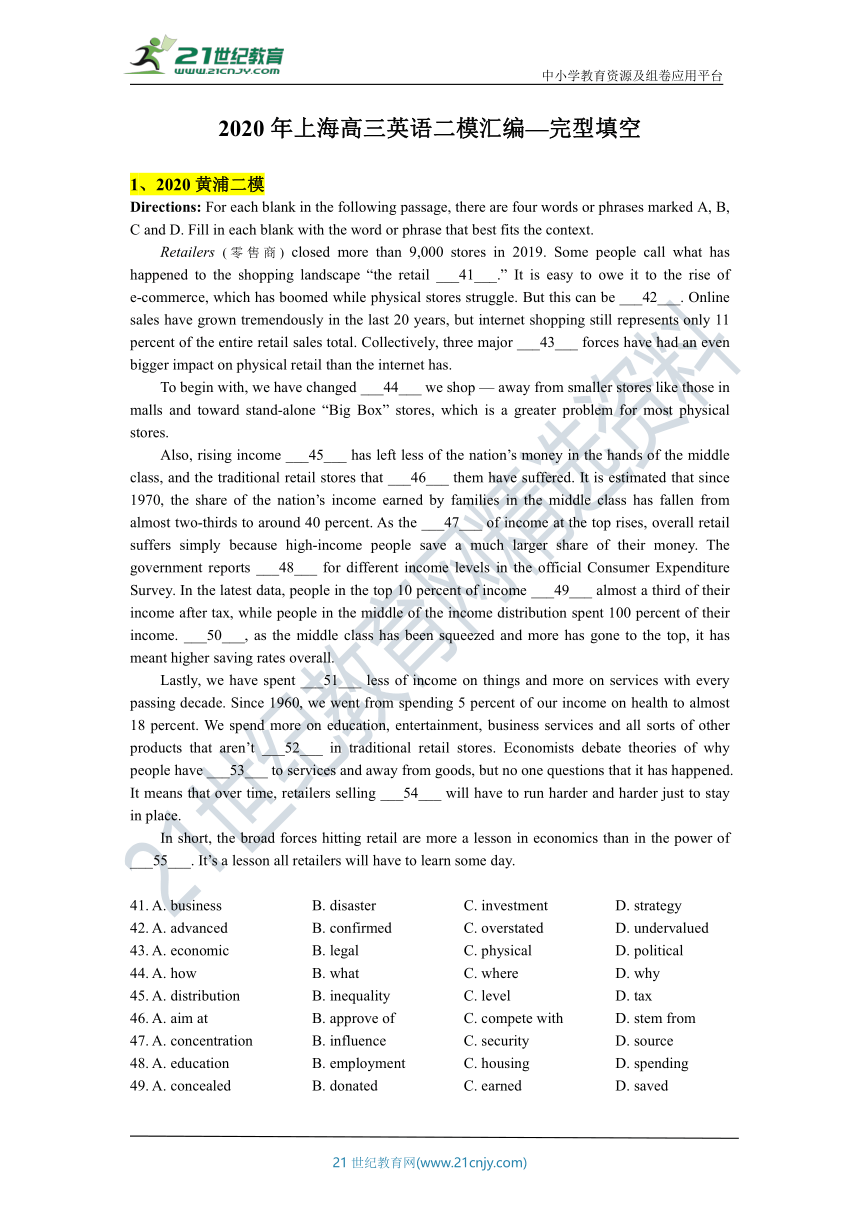
中小学教育资源及组卷应用平台 2020年上海高三英语二模汇编—完型填空 1、2020黄浦二模 Directions: For each blank in the following passage, there are four words or phrases marked A, B, C and D. Fill in each blank with the word or phrase that best fits the context. Retailers (零售商) closed more than 9,000 stores in 2019. Some people call what has happened to the shopping landscape “the retail ___41___.” It is easy to owe it to the rise of e-commerce, which has boomed while physical stores struggle. But this can be ___42___. Online sales have grown tremendously in the last 20 years, but internet shopping still represents only 11 percent of the entire retail sales total. Collectively, three major ___43___ forces have had an even bigger impact on physical retail than the internet has. To begin with, we have changed ___44___ we shop — away from smaller stores like those in malls and toward stand-alone “Big Box” stores, which is a greater problem for most physical stores. Also, rising income ___45___ has left less of the nation’s money in the hands of the middle class, and the traditional retail stores that ___46___ them have suffered. It is estimated that since 1970, the share of the nation’s income earned by families in the middle class has fallen from almost two-thirds to around 40 percent. As the ___47___ of income at the top rises, overall retail suffers simply because high-income people save a much larger share of their money. The government reports ___48___ for different income levels in the official Consumer Expenditure Survey. In the latest data, people in the top 10 percent of income ___49___ almost a third of their income after tax, while people in the middle of the income distribution spent 100 percent of their income. ___50___, as the middle class has been squeezed and more has gone to the top, it has meant higher saving rates overall. Lastly, we have spent ___51___ less of income on things and more on services with every passing decade. Since 1960, we went from spending 5 percent of our income on health to almost 18 percent. We spend more on education, entertainment, business services and all sorts of other products that aren’t ___52___ in traditional retail stores. Economists debate theories of why people have ___53___ to services and away from goods, but no one questions that it has happened. It means that over time, retailers selling ___54___ will have to run harder and harder just to stay in place. In short, the broad forces hitting retail are more a lesson in economics than in the power of ___55___. It’s a lesson all retailers will have to learn some day. 41. A. business B. disaster C. investment D. strategy 42. A. advanced B. confirmed C. overstated D. undervalued 43. A. economic B. legal C. physical D. political 44. A. how B. what C. where D. why 45. A. distribution B. inequality C. level D. tax 46. A. aim at B. approve of C. compete with D. stem from 47. A. concentration B. influence C. security D. source 48. A. education B. ... ...
~~ 您好,已阅读到文档的结尾了 ~~

